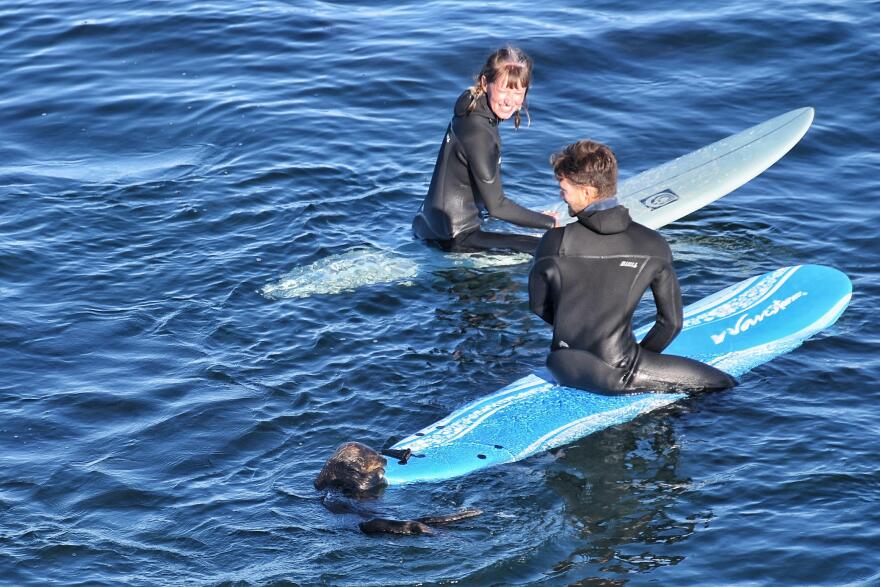The best surf spots in Santa Cruz have long been infamous for territorial locals and some occasionally aggressive confrontations. But lately, not all of the offenders have been human.
Patricio Guerrero and Pol Riera were at the iconic surf spot Steamer Lane early last week with about 10 other people, when a sea otter started grabbing onto their surfboards and biting into the foam.
“I started spinning in circles, and the otter was following the tail. And then it got bored of me and went to Pol. And then it really did some work on Pol's board,” Guerrero said.
“It just took a chunk of the nose of the board I was riding,” Riera said. “And then it went to another guy and just, like, literally destroyed the soft top of the other guy that was surfing there."
Known to officials as Otter 841, the southern sea otter has started chasing surfers around Steamer Lane and Cowells. She has an affinity for gnawing on soft-top surfboards and flippers, but has so far left people alone.
Biologists still aren’t sure why.
“The fact that we don't see this behavior very often in sea otters means we don't know a lot about it,” said Colleen Young, an environmental scientist and sea otter biologist at the California Department of Fish and Wildlife.
Young says one possible explanation for 841’s strange behavior is that a hormone change is making her feel territorial or possessive. Another theory is that she might have a positive association from a past interaction — like someone feeding her. But Young says officials haven’t witnessed that, so they can’t say with certainty.

Otter 841 has been on local biologists’ radar for some time. She was raised in captivity by her mother, who herself was caught after repeatedly approaching kayakers.
And this is not the first time 841 has gone after surfboards. She’s gotten onto boards at least twice before — once in September at Steamer Lane and again last month at Cowells.
Officials tried to capture her last fall, but their attempts ended up scaring her away from people, and she stopped approaching surfers for several months. After she resumed her unhealthy habit, scientists tried once again to scare her away from surfboards and people.
“We'd splash, make lots of noise… as soon as she would make contact with the board, she'd get a spray of citronella,” described Young.
But that didn’t work for long.

Now, Young and a team of experts from CDFW, the Monterey Bay Aquarium and the U.S. Fish and Wildlife Service are trying to catch the otter and relocate her. The biologists say they need to move her into captivity so she doesn’t end up biting someone or getting hurt. But so far, 841 has evaded them.
“We're basically having to modify all of our usual capture techniques and try to just get creative,” said Young. The otter’s previous encounters with biologists made her wary of nets, and her behavior shifts from day to day, making it difficult to plan a capture in advance.
“As soon as she sees a net, she is out of there,” said Young.
The team tried baiting her with one of the foam boards she had destroyed. No success.
They also attempted a “clandestine underwater approach,” where two scuba divers mount a trap on a scooter and sneak up on the otter from below. But that technique requires specialized equipment and near-perfect conditions, and 841 spends much of her time in murky water around thick beds of kelp.

“I was able to get under her, but I wasn't able to get the trap high enough out of the water to have it around her enough to actually get her in the trap,” Young said.
It might take weeks, but the team will keep trying.
“We're basically bringing in everybody who has experience catching otters to try to help with this,” Young said.
The U.S. Fish and Wildlife Service says capture efforts might be suspended or halted entirely if ocean conditions prevent it. Or, if 841’s interactions with people stop.
“Ocean users should understand and respect the risks posed by entering ocean waters and the plethora of ocean life that call these waters home,” the agency said in a statement. “Teams will continue to attempt safe capture of this sea otter and will coordinate with suitable licensed facilities to provide her with long-term care as an ambassador for her species in a zoo or aquarium.”

In the meantime, officials put up signs at the entrances to the water. They caution people to keep their distance from the otter and other wild animals.
And surfers, who have turned Otter 841 into an online meme that includes an Instagram account and T-shirts, jokingly ask that people also keep their distance from Steamer Lane.
“I'm never going back, man,” says Guerrero with a grin. “For whoever is hearing this: Don't go to Steamer Lane. It’s scary.”



